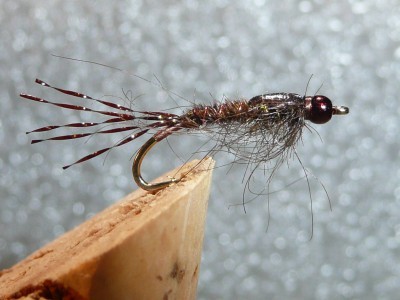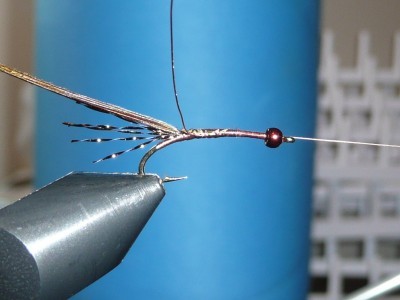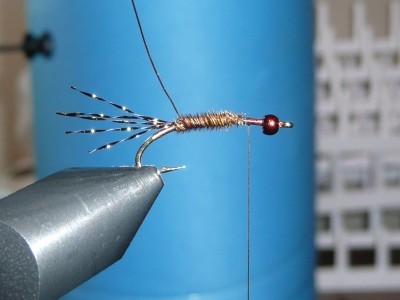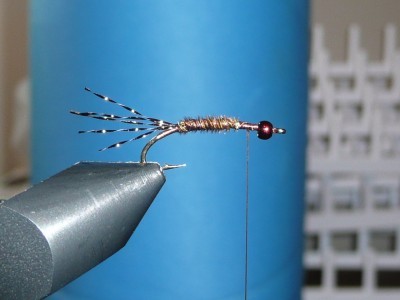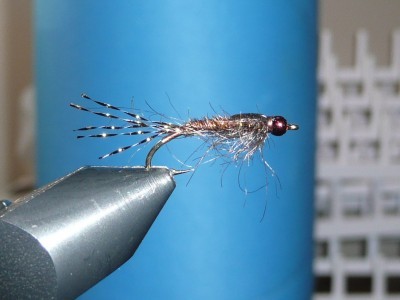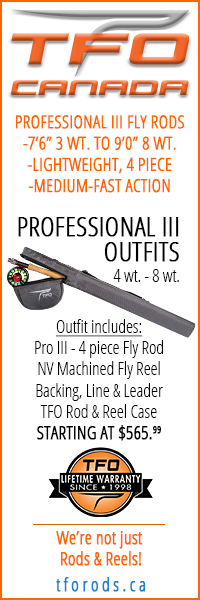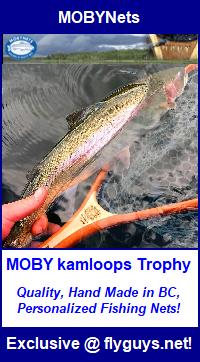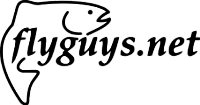Alpha Baetis Mayfly Nymph Fly Pattern ..
About four years ago we found ourselves in the middle of a huge mayfly hatch on world famous Sheridan lake.
Sheridan is one of the BC Interiors most challenging yet rewarding lakes … and by rewarding I mean that if you catch enough fish you stand a very good chance of netting a few in the double digits! 😯 It stands to reason on a lake like this that when the hatch is on you don’t want to have to stop fishing for any reason. We were doing OK but the problem was that the fish were destroying our flies, which at the time were mostly Pheasant Tail and Hare’s Ear Nymphs.
That evening we hit the bench to see what we could do. We stuck with pheasant tail as a perfect imitator of the mayfly’s gilled body, and with the hare’s ear’s dubbing concept for the thorax, but subbed in alternate materials for the fragile areas of both traditional flies – specifically the tails and wing cases. The result was the “Alpha Baetis Mayfly Nymph Fly” and it proved its self the very next day. It continues to be one of our go to bugs when ever the Callibaetis genera nymphs have the bow’s attention.
Originally tied with a copper bead we have since kicked it up a notch by incorporating the all new “Cool” Bead series into the mix. We now use the “cool brown” bead on the darker nymphs, copper for the light brown and tan patterns, and golden chartreuse for the green tone flies.
OK enough of that, here’s how we tie the Alpha Baetis Mayfly Nymph Fly (this particular one in brown) ………..
Alpha Baetis Mayfly Nymph Fly | Material List:
 Thread: Black – 8/0
Thread: Black – 8/0- Hook: Natural Bend – Size #14
- Bead: “Cool Brown” – Size 5/64
- Body: Pheasant Tail – Brown
- Rib: Copper Wire – Size Small
- Thorax: Stillwater Dubbing – Brown
- Wing Case: Scud Back – Brown
- Tail: Krystal Flash – Brown
- Head Cement: “krazy” Glue
Alpha Baetis Mayfly Nymph Fly | Tying Instructions:
1. Slip a bead on a hook, set it in the vise and start your thread:
2. Tie in a half dozen or so strands of Krystal Flash for the tail:
3. Tie in a few strands of pheasant tail (by the tips) and a piece of copper wire for the rib:
4. Wind the pheasant tail up just past the mid point forming an even tapered body as you go – tie it off and remove the excess:
5. Now counter wind the copper wire forward to form an even spaced rib. Tie off and remove the excess.
6. Tie in the scud back wing case and let it sit back over the body. Prepare and spin a dubbing loop where the body ends and the thorax will begin:
7. Wind the dubbing forward building up a nice even thorax (about twice the thickness of the body) and then pull the scud back over top and tie it down. Be careful not to crowd the eye with the dubbing.
8. Whip finish, brush some legs out of the dubbing with a Velcro brush and hit it with a bit of krazy glue … that’s it, your done! 🙂
Alpha Baetis Mayfly Nymph Fly | Fishing it …
Fish the Alpha Baetis Mayfly Nymph Fly near or on weedy bottoms of shallows, shoals and drop offs. In the absence of an emergence imitate the nymph crawling amongst the weeds by working the fly slowly along the bottom with a few short quick jerks thrown in every 20 to 30 seconds. During a hatch retrieve the fly slowly but steadily upward through the water column with a pause for several seconds every once in a while.
And that’s the Alpha Baetis Mayfly Nymph Fly Pattern!
Tight lines! 😎
*** if you’re interested in custom tied, time tested & proven effective BC Interior fly patterns, but would rather buy than tie, please Contact us for details!
*** for more effective BC stillwater fly fishing patterns be sure to check out all of flies on our BCs best fly patterns index page!
Like our stuff? Subscribe by ![]() Feed or
Feed or ![]() Email
Email .jpg)

